Bow Light Review: Finding the Best Navigation Lights for Your Boat

Boat lighting is a vital safety requirement for vessels that operate at night or in low-light conditions. A reliable bow light helps boat operators stay safe on the water and meet maritime regulations. Other vessels can identify a boat’s position and direction of travel through these vital components, which prevents potential risks on the water.
LED bow lights now come with advanced features. They include port and starboard indicators and IP67 waterproof ratings that make them perfect for small boats. This piece gets into the top bow navigation lights in the market and compares their durability, brightness, and installation needs. Boat owners will find key features to think about when they pick the perfect bow light that matches their specific boating needs.
Types of Bow Lights
Today’s vessels employ several different bow lighting systems, and LED technology has become the standard in the industry. LED bow lights have become a revolutionary force in marine navigation. These lights are brighter and use just one-tenth of the power compared to traditional incandescent bulbs.
The most common configurations include:
- Sidelights (separate red and green)
- Bi-color lights (combined red/green in single fixture)
- Tri-color lights (combines red, green, and white)
LED bow lights work better than traditional lighting systems in many ways. They produce more lumens and use less electricity in a compact, energy-efficient design. These lights run cooler than older models and come with multiple color temperature choices – neutral, warm, and cool white.
Boats under 12 meters must have sidelights that are visible from one nautical mile according to regulations. Portable LED navigation lights have gained popularity among small boat owners, especially when they have no 12V electrical systems.
Modern LED fixtures now come with advanced features like ‘white tuning’ that lets boaters adjust color temperatures using touchscreen controls. LED systems cost more upfront, but their long lifespan and lower power needs make them a budget-friendly option for most boat owners.
Top Bow Light Models Reviewed
Several manufacturers lead the marine lighting industry with innovative bow light solutions that blend durability and advanced features. The Mantus Navigation Light excels with versatile functionality and has five distinct operation modes with USB-C charging capability. This premium model ensures 2 nautical miles of visibility and has both bi-color and tri-color options.
The Vision X Bow Hull Light Kit shines with 4,004 lumens and reaches beam distances of 490 feet. Its aluminum housing and IP68/69K rating make it perfect for harsh maritime environments.
Innovative Lighting’s LED bow/stern lights work great for smaller vessels. These units give reliable visibility and run up to 100 hours on standard AA batteries. The package comes with port and starboard indicators that use quality rubber-covered switches like those in premium flashlights.
Key features comparison of top models:
| Model | Visibility Range | Special Features | Power Source |
|---|---|---|---|
| Mantus | 2 Nautical Miles | 5 Operation Modes | USB-C/Solar |
| Vision X | 490 feet | 4,004 lumens | 9-32V DC |
| Innovative | Standard | Float-capable | AA Batteries |
Attwood fixtures stand out because of their reliability and excellent customer support. Their LED models last longer than traditional incandescent options, though some boaters prefer conventional bulbs because they’re easier to replace.
Key Features to Consider
The waterproof rating is a vital consideration at the time of choosing a bow light for marine applications. Deck-mounted navigation lights that face direct sea spray need a minimum rating of IP65. IP66 or IP67 ratings provide better protection.
LED bow lights have transformed marine lighting completely. These modern fixtures provide better illumination and consume nowhere near as much power. This makes them perfect for long nighttime operations. The units need proper visibility ranges – sidelights must be visible from 112.5 degrees and one nautical mile away.
These technical specifications need careful assessment:
- Input voltage compatibility (typically 9-33VDC)
- Beam angle requirements (112.5° for port/starboard)
- Lifetime rating (30,000+ hours for quality LEDs)
- Housing material (polycarbonate or brass preferred)
The right mounting location affects performance and compliance by a lot. Navigation lights need positioning that prevents operator’s vision from glare. Vessels under 12 meters must have their all-round white light mounted at least one meter above the sidelights.
Weather resistance is vital especially when you have constant exposure to harsh marine conditions. Quality bow lights use weatherproof brass construction or high-grade polycarbonate housings to curb UV degradation and saltwater corrosion.
Conclusion
LED technology has made bow light selection a crucial choice for boat owners. These lights work better than ever, with excellent efficiency, durability, and visibility. Navigation lights now come with multiple operation modes, better waterproof protection, and longer battery life. Modern bow light options are substantially more reliable and budget-friendly compared to older versions.
Smart boat owners know quality bow lights will save them money through lower power usage and less maintenance while making their boats safer. Different vessels need different features. Small craft can use simple battery-powered units, while larger boats might need permanent installations with advanced controls. A proper look at waterproof ratings, mounting needs, and visibility requirements will help meet maritime rules and keep nighttime navigation safe.
FAQs
- What are the standard navigation lights required on a boat?
The standard navigation lights for a boat include a stern light visible over 135 degrees and from two miles away, a masthead light, and red and green sidelights visible over 112.5 degrees and from a distance of one mile. Together, the masthead and stern lights cover a full 360 degrees. - How do anchor lights differ from navigation lights?
Anchor lights and navigation lights serve different purposes. Navigation lights indicate the direction and movement of a vessel, helping to prevent collisions, while anchor lights signal that a boat is stationary and anchored. - What navigation lights are necessary for a power boat under 26 feet in length?
For power-driven vessels less than 26 feet long, the required lights include red and green sidelights that are visible from at least one mile away, and either an all-round white light or both a masthead light and a sternlight. - What are the lighting requirements for boats under 23 feet during low visibility or at night?
Sailboats or vessels using paddles or oars under 23 feet must have one white navigation light (or a lantern or flashlight) that is visible from 2 nautical miles away, applicable between sunset and sunrise or during periods of reduced visibility.

